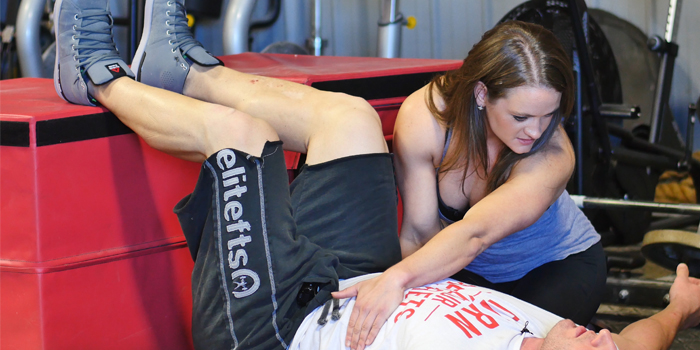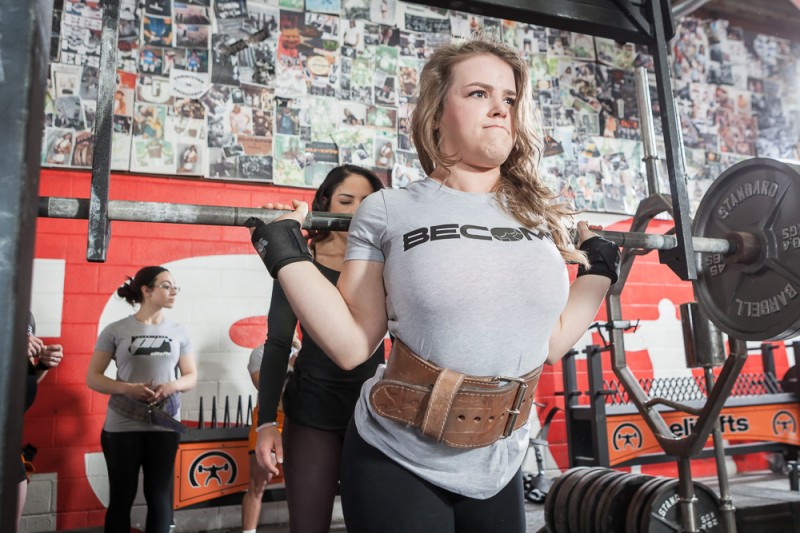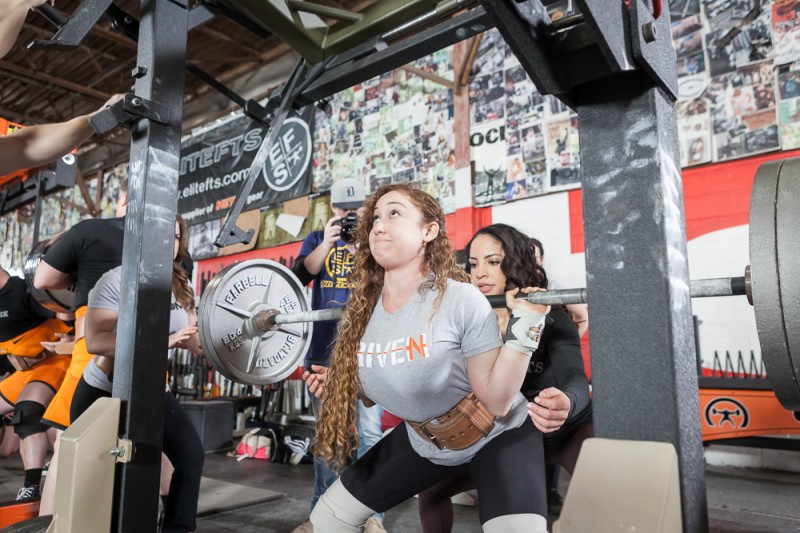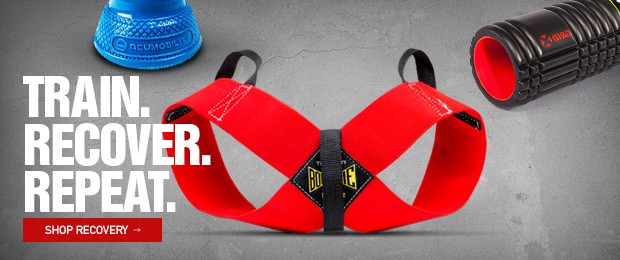
I am clearly not a big, jacked dude. But I train with a bunch, and it seems like every off-season or inevitably in some point in their training cycle, everyone rotates between different bars and modifies training, decrease specificity, and play a game of elbow sleeve Russian roulette.
I’m all about variability, but there has to be a good purpose behind training it. Increasing variability for the sole purpose of pain reduction tells me you’ve found a good way to train around a mechanical issue or injury, which is a good alternative to constantly irritating whatever tissue is involved, but you aren’t fixing the root of the issue. I see people complete a perfectly timed cycle of when to alternate in certain bars as a response to pain rather than seeking them specifically for training adaptation. At some point you kind of wonder when you’re exchanging one for the other: training around pain versus training to improve deficiency.
RECENT: Identifying Hip Impingement Causes and Solutions
You’ll continue to get stronger, but consistently, six to eight weeks out from a meet, it looks like you guys go through a cycle of “just make sure my elbows and shoulders don’t explode” while trying to peak.
Let training tools be training tools to challenge you, instead of ways to work around pain-related deficiencies.
Mechanical Breakdown
Everyone’s technique is just a hair different, and with the literature citing more and more examples of differences in human morphology and makeup, it makes sense that low bar positions, regional, and global responses will exhibit some degree of variability between lifters. The degree to which your body requires or accesses certain ranges of motion within the general “low bar” requirements will differ from someone else. Generally, however, you require a degree of both thoracic and shoulder mobility, and what I’m going to call “thoracic extensor strength”, though I personally think an immobile thoracic spine (one that is locked up) is as big a player in determining one’s ability to even access the required thoracic mobility where you need to be “strong.”
Where you lack motion or motor control, your body will pass down the chain to the next moving part that can buy you an extra bit to help you get into position. This is dysfunction.
Every time I write I wish I had a three-dimensional animated model that I could zoom out, zoom in, and highlight the mechanical changes. I can write words and most people will generally accept that, yes, thoracic mobility will influence shoulder stuff. In the last article I wrote, I made a huge point about being able to appreciate, three-dimensionally, what is actually happening in a fluid structure trying to generate stiffness under a bar. I want that for you again, because the more of that you understand and appreciate, the more likely you are to find a solution to your pain rather than trying 600 randomized Instagram rehab posts.
Spine-Ribcage-Shoulder Blade-Shoulder Joint-Elbow-Wrist/Hand
That’s the functional train you’re looking at with your shoulder and elbow pain. Lacking mobility in one of the initial segments will increase the demand for mobility on another. Something like an SS Yoke Bar or Duffalo Bar decreases the demand on the further segments that are often the symptomatic ones, which helps reduce the stress temporarily. But if that’s your only solution, it’s only a matter of time under a straight bar until symptoms return.
I have the first half of that train bolded because they’re often the bigger culprits in your pain. And while there are lots of different places you can look for solutions and structures (whether it be spine, muscles, joint capsules themselves, or motor control), if I were to pick one big bang-for-your-buck structure to pick on to change, I’d pick your lat.
I think you love them too much — and for good reason, because we need them in each of the big three. But at some point they become too “busy.” Notice I didn’t say too strong. We’re great at training our lats to become strong, but at some point, the pursuit of strength in your lats has likely locked you up regionally throughout your spine, ribcage, and shoulder. The meathead in me just died a little bit.
When I say your lat is too busy, I mean that it’s being overused for tasks it doesn’t need to be. Think about it having a certain volume level, and you could equate it to being all the way up, all the time, rather than operating somewhere in the middle of ups and downs as needed to meet the demands of the task. A chronically elevated volume will make it appear tight.
Most meatheads know what a lat “does.” And while being limited in overhead movement is fine, many of us will say, "Well, I just don’t need to do overhead work if I can’t get there,” or “Front rack? Nah, I’ll just cross arms.” An educated meathead will also tell you how a lat can influence lumbar spine posture by pulling you into excessive extension, making it tough to find your core.
One extra layer for you to consider: Go to Google and look up thoracic lat insertion. Big muscles mean big pull, and this muscle is huge. They look like pillows on the side of most spines. The very first picture that shows up on that search is one that illustrates just how influential this muscle is on shoulder, ribcage, and spine mechanics. Pretty sure that matches up with the first three muscles in the train I bolded a few paragraphs ago. Look just how high onto your spine your lat actually runs — halfway through your thoracic region!
I’ve written in numerous articles that we need to stop thinking about a muscle as completing one action and instead look at fiber orientation of that muscle — the lat is a prime example. If you can envision what almost look to be different segments within your lat, you can see that a huge directional pull isn’t always just on the humerus, and encompasses more than what our textbook tells us a lat does with shoulder motion. That fluid three-dimensional model will show you how, while you’re locked up and locked in, your lumbar spine extends and your lower ribcage and thoracic spine are pulled into that “locked” posture, while your shoulder has forces pulling it into internal rotation and relative adduction. Your lat will pull your thoracic spine into a flattened position rather than the curvature it should have. Your ribcage will follow because—surprise—your ribs' anchor point is your thoracic spine. Your curved shoulder blade now sits on a ribcage that is flattened, with increased “business” in a muscle that puts the ball of your shoulder ball and socket into a position of relative internal rotation. Inside a socket (that’d be your shoulder blade), that is a curved surface trying to sit on a flat one (ribcage) and has poor congruency. As a consequence, do you think your pecs are shortened or lengthened? Think that might be related to that tight pec minor you keep trying to release with your lacrosse ball every day?
I think you see where I’m going.
You can keep going at your mobility work. I think locally—meaning at the shoulder—that’s important, but you have to look one step beyond that to really get to the issue.
Each time you get under a heavy bar, the lat affects your thoracic spine, ribcage, and shoulder, giving it a huge response to be as busy (think: volume ALL the way on), that increases as load increases. If you’re not conscientiously giving it a reason to turn the volume down, it can stay in that state of hypertonicity throughout your accessory work and the rest of life. Coax it. Give it a reason to let your spine and shoulders move when you aren’t under load, with the goal movements being what you lack underneath a bar: thoracic extension, lumbar neutral (think ribs down) and shoulder neutrality or slight external rotation.Remember, that’s the whole point of all that background knowledge I just tried (hopefully with success) to give you. You may or may not need more strength in those motions, but you won’t know until you teach your body first to access them. You can’t strengthen a motion your body can’t get into, to begin with.
Release first, then regroove.
Because lat and thoracic tightness/mobility can influence shoulder mechanics, neck tightness, and regionally almost anything if you have longstanding issues, I strongly urge you to go see a healthcare professional, PT or chiropractor that will help you get to the root of the issue.
If your issues really only happen after straight bar squatting for a few microcycles, there are a few places you can start, or keys to look to, when looking at the role of tight lats in limiting your mobility to get underneath a bar. But it really is more about how you do something rather than what exactly you do. This will take some trial and error.
Keys when doing thoracic mobility work for shoulder function more so than lumbar:
Feel your mid/upper back release. Don’t look for a stretch just where you would traditionally think about a lat. Appreciate the length of attachment throughout the thoracic spine, and if you feel a stretch between your shoulder blades somewhere (even if flexion-based; remember you can’t extend if you’re immobile and have limited motion to begin with), stay there. Input to receptors that monitor muscle length and encourage change is exactly what you’re looking for, even if it’s not perfect.
Note thumb position. Given that a lat will internally rotate a shoulder, if you’re trying to give external rotation input, try the thumb/palm up position rather than thumb/palm down.
Don’t forget other secondarily involved muscles and regions, specifically, the pecs, obliques, and ribcage given the anatomy mentioned in this article.
Check your ego for some movements. There’s a time to go heavy but it may not hurt to finish (or use as a warm-up) full range that leads to you actually attaining the posture and position you want under a bar. My favorite? Prone/chest supported rows on an incline bench, with light weight, finding the position you want under a bar. That includes the lumbar spine and pelvis.
Less may be more. Receptors that tell your brain how tight/loose to let muscles be can benefit from long, sustained, low-intensity input, provided it’s at least at a sufficient threshold to feel some stretch. Think about it like you’re coaxing your body to work with you rather than beating it into submission.
There are a ton of solutions out there, but in general, you have to find what works for you. Most of those solutions will work if executed properly with the above-mentioned principles. A few of my favorite resources/basic principles:
- The ideas of “reaching and rounding” to attain mobility. Quinn Henoch put out an article a few years ago where he teaches us to quit demonizing thoracic flexion.
- The understated role of the serratus anterior in ribcage mechanics and stability to help oppose/balance our overstated lats.
- IFAST, Eric Cressey, Resilient Performance PT, and Parabolic PT for inhibition techniques.
- Dr. John Rusin, Eric Cressey, and Dr. Zach Long for thoracic mobility once you’ve actually unlocked what’s tight.
I’m always available to help via email (danicashdpt@gmail.com), and truthfully this may be one of the bigger issues I support going to a healthcare provider with. But again, if pointed in the right direction, learn to fish. There’s a reason I try not to remake videos that have already been made, and been made better than I would have thought to. Learning to fish will absolutely, 100%, change the way you train and approach your body. That is what this learning is about, to begin with.













2 Comments